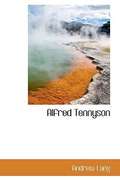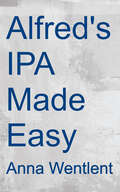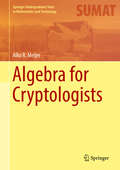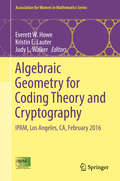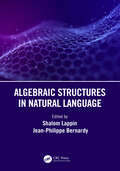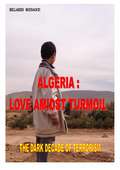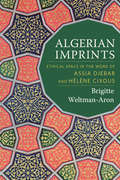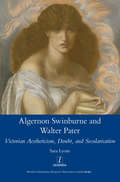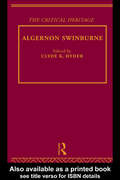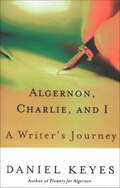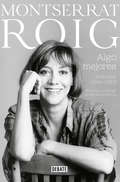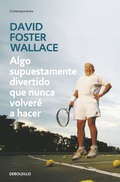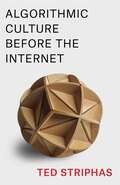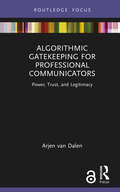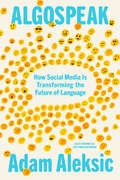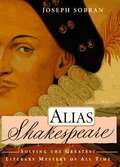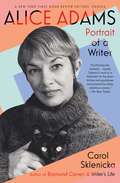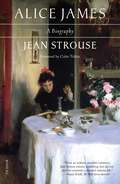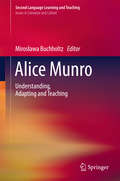- Table View
- List View
Alfred Tarski: Philosophy of Language and Logic
by Douglas PattersonThis study looks to the work of Tarski's mentors Stanislaw Lesniewski and Tadeusz Kotarbinski, and reconsiders all of the major issues in Tarski scholarship in light of the conception of Intuitionistic Formalism developed: semantics, truth, paradox, logical consequence.
Alfred Tennyson
by Andrew LangINTRODUCTION. IN writing this brief sketch of the Life of Tennyson, and this attempt to appreciate his work, I have rested almost entirely on the Bio- graphy by Lord Tennyson with his kind per- mission and on the text of the Poems. <P> <P> As to the Life, doubtless current anecdotes, not given in the Biography, are known to me, and to most people. But as they must also be familiar to the author of the Biography, I have not thought it desirable to include what he rejected. The works of the localisers I liave not read Tennyson disliked these researches, as a rule, and they appear to be unessential, and often hazardous. The professed commentators I have not consulted. It appeared better to give ones own impressions of the Poems, unaffected by the impressions of others, except in one or two cases where matters of fact rather than of taste seemed to be in question. Thus on two or three points I have ventured to differ from a distinguished living critic, and have given the reasons for my dissent. . .
Alfred's Ipa Made Easy: A Guidebook For The International Phonetic Alphabet
by Anna WentlentHow many years has it been since your last diction class? This handy guidebook is an easy reference for the symbols used in IPA: what they look like and how they are pronounced. Example words for every symbol are included in English, Latin, Italian, German, French, and Spanish. And an online resource includes recorded demonstrations of every sound. A clear and concise tool for singing in foreign languages, equally useful in the choir room and the vocal studio.
Algebra for Cryptologists (Springer Undergraduate Texts in Mathematics and Technology)
by Alko R. MeijerThis textbook provides an introduction to the mathematics on which modern cryptology is based. It covers not only public key cryptography, the glamorous component of modern cryptology, but also pays considerable attention to secret key cryptography, its workhorse in practice. Modern cryptology has been described as the science of the integrity of information, covering all aspects like confidentiality, authenticity and non-repudiation and also including the protocols required for achieving these aims. In both theory and practice it requires notions and constructions from three major disciplines: computer science, electronic engineering and mathematics. Within mathematics, group theory, the theory of finite fields, and elementary number theory as well as some topics not normally covered in courses in algebra, such as the theory of Boolean functions and Shannon theory, are involved. Although essentially self-contained, a degree of mathematical maturity on the part of the reader is assumed, corresponding to his or her background in computer science or engineering. Algebra for Cryptologists is a textbook for an introductory course in cryptography or an upper undergraduate course in algebra, or for self-study in preparation for postgraduate study in cryptology.
Algebraic Geometry for Coding Theory and Cryptography: IPAM, Los Angeles, CA, February 2016 (Association for Women in Mathematics Series #9)
by Everett W. Howe Kristin E. Lauter Judy L. WalkerCovering topics in algebraic geometry, coding theory, and cryptography, this volume presents interdisciplinary group research completed for the February 2016 conference at the Institute for Pure and Applied Mathematics (IPAM) in cooperation with the Association for Women in Mathematics (AWM). The conference gathered research communities across disciplines to share ideas and problems in their fields and formed small research groups made up of graduate students, postdoctoral researchers, junior faculty, and group leaders who designed and led the projects. Peer reviewed and revised, each of this volume's five papers achieves the conference's goal of using algebraic geometry to address a problem in either coding theory or cryptography. Proposed variants of the McEliece cryptosystem based on different constructions of codes, constructions of locally recoverable codes from algebraic curves and surfaces, and algebraic approaches to the multicast network coding problem are only some of the topics covered in this volume. Researchers and graduate-level students interested in the interactions between algebraic geometry and both coding theory and cryptography will find this volume valuable.
Algebraic Structures in Natural Language
by Jean-Philippe BernardyAlgebraic Structures in Natural Language addresses a central problem in cognitive science concerning the learning procedures through which humans acquire and represent natural language. Until recently algebraic systems have dominated the study of natural language in formal and computational linguistics, AI, and the psychology of language, with linguistic knowledge seen as encoded in formal grammars, model theories, proof theories and other rule-driven devices. Recent work on deep learning has produced an increasingly powerful set of general learning mechanisms which do not apply rule-based algebraic models of representation. The success of deep learning in NLP has led some researchers to question the role of algebraic models in the study of human language acquisition and linguistic representation. Psychologists and cognitive scientists have also been exploring explanations of language evolution and language acquisition that rely on probabilistic methods, social interaction and information theory, rather than on formal models of grammar induction. This book addresses the learning procedures through which humans acquire natural language, and the way in which they represent its properties. It brings together leading researchers from computational linguistics, psychology, behavioral science and mathematical linguistics to consider the significance of non-algebraic methods for the study of natural language. The text represents a wide spectrum of views, from the claim that algebraic systems are largely irrelevant to the contrary position that non-algebraic learning methods are engineering devices for efficiently identifying the patterns that underlying grammars and semantic models generate for natural language input. There are interesting and important perspectives that fall at intermediate points between these opposing approaches, and they may combine elements of both. It will appeal to researchers and advanced students in each of these fields, as well as to anyone who wants to learn more about the relationship between computational models and natural language.
Algeria: The Dark Decade of Terrorism (Novel #1)
by Bellaredj BoudaoudIn this story, the author denounces religious fanaticism, assassins, attacks, intolerance, hypocrisy and even a total incomprehension of Islam. A religion that preaches peace and not violence. Generally speaking, violence is inherent in human nature. It takes a commendable effort to suppress it. Our father Adam had two sons: one killed the other. Monotheistic religions strive to neutralize tendencies towards violence through patience, piety and love of neighbor. The author portrays here a realistic and sometimes picturesque image of the life of a people he loves, plunged into the chaos of history, with its violence and dangers, its hopes and passions. Little by little, the truth and exactitude of the details, the non-documentary precision, A religion that preaches peace and not violence.
Algerian Imprints: Ethical Space in the Work of Assia Djebar and Hélène Cixous
by Brigitte Weltman-AronBorn and raised in French Algeria, Assia Djebar and Hélène Cixous represent in their literary works signs of conflict and enmity, drawing on discordant histories so as to reappraise the political on the very basis of dissensus.In a rare comparison of these authors' writings, Algerian Imprints shows how Cixous and Djebar consistently reclaim for ethical and political purposes the demarcations and dislocations emphasized in their fictions. <P><P>Their works affirm the chance for thinking afforded by marginalization and exclusion and delineate political ways of preserving a space for difference informed by expropriation and nonbelonging. Cixous's inquiry is steeped in her formative encounter with the grudging integration of the Jews in French Algeria, while Djebar's narratives concern the colonial separation of "French" and "Arab," self and other. Yet both authors elaborate strategies to address inequality and injustice without resorting to tropes of victimization, challenging and transforming the understanding of the history and legacy of colonized space.
Algerian Languages in Education: Conflicts and Reconciliation
by Salim Bouherar Abderrezzaq GhafsiThis book examines the role of foreign languages and cultures in the Algerian educational system, highlighting how cultural imperialism and supremacy persist through damaging language ideologies and the privileging of colonial languages such as French and English. The authors challenge the claim that the Algerian educational system can be considered ‘neutral’, arguing instead that it was and still is the outcome of a conflict between Arabised and Francophone elites, serving strategic and ideological objectives rather than cultural or pedagogical goals. This book will be relevant to students and scholars of language education, language policy and planning, and the history and politics of the Arab and Muslim world, especially those interested in the influence of Western languages and cultures and the democratisation of educational systems.
Algernon Swinburne and Walter Pater: Victorian Aestheticism, Doubt and Secularisation
by SarahGlendon LyonsHow did literary aestheticism emerge in Victorian Britain, with its competing models of religious doubt and visions of secularisation? For Lyons, the aestheticism developed and progressively revised by Algernon Charles Swinburne (1837-1909) and Walter Pater (1839-1894) illuminates the contradictory impulses of modern secularism: on the one hand, a desire to cast itself as a form of neutrality or disinterestedness; on the other, a desire to affirm 'this world' as the place of human flourishing or even enchantment. The standard narrative of a 'crisis of faith' does not do justice to the fissured, uncertain quality of Victorian visions of secularisation. Precisely because it had the status of a confusing hypothesis rather than a self-evident reality, it provoked not only dread and melancholia, but also forms of fantasy. Within this context Lyons gives a fundamentally new account of the aims and nature of Victorian aestheticism, taking as a focus its deceptively simple claim that art is for art's sake first of all.
Algernon Swinburne: The Critical Heritage
by Clyde K. HyderThe Critical Heritage gathers together a large body of critical sources on major figures in literature. Each volume presents contemporary responses to a writer's work, enabling students and researchers to read for themselves, for example, comments on early performances of Shakespeare's plays, or reactions to the first publication of Jane Austen's novels. The carefully selected sources range from landmark essays in the history of criticism to journalism and contemporary opinion, and little published documentary material such as letters and diaries. Significant pieces of criticism from later periods are also included, in order to demonstrate the fluctuations in an author's reputation. Each volume contains an introduction to the writer's published works, a selected bibliography, and an index of works, authors and subjects. The Collected Critical Heritage set will be available as a set of 68 volumes and the series will also be available in mini sets selected by period (in slipcase boxes) and as individual volumes.
Algernon, Charlie, and I: A Writer's Journey
by Daniel KeyesThe author of Flowers for Algernon discusses the highs & lows of the writing life, as well as his methods for creating fiction.In his bestselling novel Flowers for Algernon, Daniel Keyes created an unlikely duo—a laboratory mouse and a man—who captured the hearts of millions of readers around the world. Now, in Algernon, Charlie, and I, Keyes reveals his methods of creating fiction as well as the heartbreaks and joys of being published. For the first time, readers, writers, teachers, and students can glimpse the creative life behind this cherished novel.Includes the original novelette version of Flowers for Algernon
Algo mejores: Artículos (1966-1983)
by Montserrat RoigLa voz testimonial de Montserrat Roig en un libro sin precedentes «Estos textos son tan increíblemente buenos que te pasmará que Montserrat Roig no sea hoy uno de los grandes nombres de la literatura peninsular. Ya va siendo hora de sacarla del purgatorio del olvido.»ROSA MONTERO «Una mujer irrepetible. Siento mucho que no la hayáis conocido. Pero la podéis leer.»MARUJA TORRES «La Historia no la cambiamos, es cierto, pero nosotros nos volvimos algo mejores.» Montserrat Roig formó parte de una generación de mujeres escritoras y periodistas fundamentales que sacudieron la dictadura de las costumbres y reivindicaron a la mujer libre. Ciudadana de su tiempo y poseedora de una curiosidad ilimitada, Roig, que con el tiempo fue interesadamente olvidada, fue una cronista lúcida e implacable de la historia reciente de España, y sus escritos son hoy un ejercicio de pensamiento deslumbrante. Coincidiendo con la conmemoración del que habría sido el 75 aniversario de su nacimiento, Algo mejores recupera a una de las autoras más populares no solo en el ámbito de la literatura catalana, sino también en el de la española, para que su voz vuelva a irrumpir con fuerza en nuestro presente. «En este volumen se concentran artículos de Montserrat Roig nunca antes recogidos en un libro que explican su trayectoria intelectual, sus viajes, su curiosidad, su tiempo, su trabajo. Artículos cargados de información autobiográfica que narran una vida de lucha limpia y franca oposición a los abusos de los sistemas. Feminismo, antifascismo, antiimperialismo articulados por un amor de base, sagrado y de trinchera, vértebra del pensamiento culpable de todo lo demás, la literatura.»Del prólogo de Betsabé García La crítica ha dicho... «Estos textos son tan increíblemente buenos que te pasmará que Montserrat Roig no sea hoy uno de los grandes nombres de la literatura peninsular. Ya va siendo hora de sacarla del purgatorio del olvido.» Rosa Montero «Una mujer irrepetible. Siento mucho que no la hayáis conocido. Pero la podéis leer.» Maruja Torres «Montserrat Roig, viajera, culta, feminista. [...] Montserrat Roig, luz en la noche, maestra de periodistas y escritora que nos abandonó cuando lo mejor de su producción estaba por venir. [...] Pero ahora que la prensa no experimenta una era de cambios, sino un cambio de era, está más viva que nunca. Y su ejemplo es todavía más inspirador.»Domingo Marchena, La Vanguardia «La primera escritora total de la literatura catalana.»Marta Pesarrondona
Algo supuestamente divertido que nunca volveré a hacer
by David Foster WallaceEste artículo es una de las radiografías más agudas e irreverentes de la cultura americana de fin de siglo, en la que se entremezclan la familiaridad, el asombro y una mordacidad descabellada. Foster Wallace elabora en Algo supuestamente divertido que nunca volveré a hacer una postal gigantesca basada en su experiencia en un crucero de lujo por el Caribe. Lo que a primera vista parece ser un simple viaje «para relajarse», en manos de un humor delirante y un cinismo corrosivo acabará convirtiéndose en el horror más absoluto. La crítica ha dicho...«La obra de no ficción más brillante y divertida que se ha escrito en los últimos años.»John Glassie, Time Out New York «Animado por una prosa maravillosamente exuberante [...] este volumen confirma al señor Wallace como uno de los talentos más destacados de su generación.»The New York Times «Wallace escribe con una intensidad que transforma un reportaje errático en una forma sui generis de filosofía.»Kirkus Reviews «Su instinto para reproducir lo coloquial avergonzaría a maestros como Pynchon y DeLillo, y la sobriedad humana que confiere a sus temas, de ficción o de no ficción, deberían ser un modelo para cualquiera que escriba crítica cultural, tanto en la forma de relatos como en ensayos como estos.»Publishers Weekly
Algorithmic Culture Before the Internet
by Ted StriphasToday, algorithms exercise outsize influence on cultural decision-making, shaping and even reshaping the concept of culture. How were automated, computational processes empowered to perform this work? What forces prompted the emergence of algorithmic culture?Algorithmic Culture Before the Internet is a history of how culture and computation came to be entangled. From Cambridge, England, to Cambridge, Massachusetts, by way of medieval Baghdad, this book pinpoints the critical junctures at which algorithmic culture began to coalesce in language long before it materialized in the technological wizardry of Silicon Valley. Revising and extending the methodology of “keywords,” Ted Striphas examines changing concepts and definitions of culture, including the development of the field of cultural studies, and stresses the importance of language in the history of technology.Offering historical and interdisciplinary perspective on the relationship of culture and computation, this book provides urgently needed context for the algorithmic injustices that beset the world today.
Algorithmic Gatekeeping for Professional Communicators: Power, Trust, and Legitimacy (Disruptions)
by Arjen van DalenThis book provides a critical study of the power, trust, and legitimacy of algorithmic gatekeepers. The news and public information which citizens see and hear is no longer solely determined by journalists, but increasingly by algorithms. Van Dalen demonstrates the gatekeeping power of social media algorithms by showing how they affect exposure to diverse information and misinformation and shape the behaviour of professional communicators. Trust and legitimacy are foregrounded as two crucial antecedents for the acceptance of this algorithmic power. This study reveals low trust among the general population in algorithms performing journalistic tasks and a perceived lack of legitimacy of algorithmic power among professional communicators. Drawing on case studies from YouTube and Instagram, this book challenges technological deterministic discourse around "filter bubbles" and "echo chambers" and shows how algorithmic power is situated in the interplay between platforms, audiences, and professional communicators. Ultimately, trustworthy algorithms used by news organizations and social media platforms as well as algorithm literacy training are proposed as ways forward towards democratic algorithmic gatekeeping. Presenting a nuanced perspective which challenges the deep divide between techno-optimistic and techno-pessimistic discourse around algorithms, Algorithmic Gatekeeping is recommended reading for journalism and communication researchers in related fields. The Open Access version of this book, available at http://www.taylorfrancis.com, has been made available under a Creative Commons [Attribution-Non Commercial-No Derivatives (CC-BY-NC-ND)] 4.0 license.
Algospeak: How Social Media Is Transforming the Future of Language
by Adam AleksicFrom linguist Adam Aleksic, known as @etymologynerd on social media, comes a captivating exploration of how internet algorithms are transforming language and communication in unprecedented ways. &“Packed with fascinating facts, of-the-moment observations, and a sparkling voice, Algospeak is a gift to any word nerd. Deftly covering everything from emoji etymologies and trendbait to Taylor Swift fanilects... Adam Aleksic is the wise, yet accessible internet linguistics oracle we need.&”—Amanda Montell, author of The Age of Magical Overthinking and CultishFrom &“brainrot&” memes and incel slang to the trend of adding &“-core&” to different influencer aesthetics, the internet has ushered in an unprecedented linguistic upheaval. We&’re entering an entirely new era of etymology, heralded by the invisible forces driving social media algorithms. Thankfully, Algospeak is here to explain. As a professional linguist, Adam Aleksic understands the gravity of language and the way we use it: he knows the ways it has morphed and changed, how it reflects society, and how, in its everyday usage, we carry centuries of human history on our tongues. As a social media influencer, Aleksic is also intimately familiar with the internet&’s reach and how social media impacts the way we engage with one another. New slang emerges and goes viral overnight. Accents are shaped or erased on YouTube. Grammatical rules, loopholes, and patterns surface and transform language as we know it. Our interactions, social norms, and habits—both online and in person—shift into something completely different.As Aleksic uses original surveys, data, and internet archival research to usher us through this new linguistic landscape, he also illuminates how communication is changing in both familiar and unexpected ways. From our use of emojis to sentence structure to the ways younger generations talk about sex and death (see unalive in English and desvivirse in Spanish), we are in a brand-new world, one shaped by algorithms and technology. Algospeak is an energetic, astonishing journey into language, the internet, and what this intersection means for all of us.
Algren: A Life
by Mary WisniewskiChicago Writers Association Nonfiction Book of the Year (2017) Society of Midland Authors Literary Award in Biography (2017) A tireless champion of the downtrodden, Nelson Algren, one of the most celebrated writers of the 20th century, lived an outsider's life himself. He spent a month in prison as a young man for the theft of a typewriter; his involvement in Marxist groups earned him a lengthy FBI dossier; and he spent much of his life palling around with the sorts of drug addicts, prostitutes, and poor laborers who inspired and populated his novels and short stories. Most today know Algren as the radical, womanizing writer of The Man with the Golden Arm, which won the first National Book Award, in 1950, but award-winning reporter Mary Wisniewski offers a deeper portrait. Starting with his childhood in the City of Big Shoulders, Algren sheds new light on the writer's most momentous periods, from his on-again-off-again work for the WPA to his stint as an uninspired soldier in World War II to his long-distance affair with his most famous lover, Simone de Beauvoir, to the sense of community and acceptance Algren found in the artist colony of Sag Harbor before his death in 1981. Wisniewski interviewed dozens of Algren's closest friends and inner circle, including photographer Art Shay and author and historian Studs Terkel, and tracked down much of his unpublished writing and correspondence. She unearths new details about the writer's life, work, personality, and habits and reveals a funny, sensitive, and romantic but sometimes exasperating, insecure, and self-destructive artist. The first new biography of Algren in over 25 years, this fresh look at the man whose unique style and compassionate message enchanted readers and fellow writers and whose boyish charm seduced many women is indispensable to anyone interested in 20-century American literature and history.
Alias Shakespeare: Solving the Greatest Literary Mystery of All Time
by Joseph Sobran"Who wrote Shakespeare's plays? Today, the long-standing and impassioned debate about the so-called authorship question is perceived by Shakespearean scholars as the preserve of eccentrics and cranks. But in this contrarian work of literary detection, author Joseph Sobran boldly reopens this debate and allows the members of Shakespeare's vast contemporary public to weigh all the evidence and decide for themselves." "An enormous shelf of biographical scholarship has grown up over the past 300 years around the "Swan of Avon." But what are these histories based on? Revealing that no more than a handful of fragmentary documents attest to Shakespeare's existence - and virtually none which link him to the plays themselves - Sobran delightfully debunks this elaborate egalitarian myth concocted in equal parts of speculation, wishfulness, and fantasy." "More importantly, Sobran shows how many questions the myth leaves unanswered: How could a provincial actor from Stratford gain such an intimate knowledge of court life? How could he know so much of classical authors and not own a single book? How could he write compromising love sonnets to his social superior, the powerful Earl of Southampton? How could he know so much of Italy, a place he never visited? Why was there no notice of the famous writer's death in 1616? Why, in short, does Shakespeare remain such an obscure and shadowy figure?" "Methodically demolishing the case for "Mr. Shakspere," Sobran shows it is highly implausible that he wrote the poems and plays we know as The Works of William Shakespeare. Other candidates exist, of course, including Ben Jonson, Christopher Marlowe, and Francis Bacon. Sobran dispenses with these claimants, then sets forth the startlingly persuasive case for Edward de Vere, the seventeenth Earl of Oxford." "Oxford was a widely traveled, classically educated member of the Elizabethan court. A swashbuckling spendthrift, he swung high and low in the eyes of his peers. Having spent most of his fortune on adventures in Italy and elsewhere on the Continent - like Hamlet he was captured by pirates in the English Channel - he fell into disrepute for reasons that included rumors about his homosexuality. Still he topped many lists of the best Elizabethan poets at the time, even ranking above Edmund Spenser and Sir Philip Sidney. He was an avid book collector, and a love of the literary arts ran in his family. His uncle not only pioneered the sonnet form that came to be known as Shakespearean, he also translated the English edition of Ovid that indisputably guided Shakespeare's pen. More strikingly, Oxford was the ward of Lord Burghley - the man widely acknowledged as the model for the character Polonius in Hamlet. Ultimately, Sobran shows us why a disgraced nobleman such as Oxford would have sought solace in the anonymity of writing pseudonymous plays and poetry." --BOOK JACKET. Title Summary field provided by Blackwell North America, Inc. All Rights Reserved
Alice Adams: Portrait of a Writer
by Carol Sklenicka&“Nobody writes better about falling in love than Alice Adams,&” a New York Times critic said of the prolific short-story writer and bestselling novelist whose dozens of published stories and eleven novels illuminate the American Century. Born in 1926, Alice Adams grew up in Chapel Hill, North Carolina, during the Great Depression and came of age during World War II. After college at Radcliffe and a year in Paris, she moved to San Francisco. Always a rebel in good-girl&’s clothing, Adams used her education, sexual and emotional curiosity, and uncompromising artistic ambition to break the strictures that bound women in midcentury America. Divorced with a child to raise, she worked at secretarial jobs for two decades before she could earn a living as a writer. One of only four winners of the O. Henry Special Award for Continuing Achievement, Adams wove her life into her fiction and used her writing to understand the changing tides of the twentieth century. Her work portrays vibrant characters both young and old who live on the edge of their emotions, absorbed by love affairs yet always determined to be independent and to fulfill their personal destinies. With the same meticulous research and vivid storytelling she brought to Raymond Carver: A Writer&’s Life, Carol Sklenicka integrates the drama of Adams&’s deeply felt, elegantly fierce life with a cascade of events—the civil rights and women&’s movements, the sixties counterculture, and sexual freedom. This biography&’s revealing analyses of Adams&’s stories and novels from Careless Love to Superior Women to The Last Lovely City, and her extensive interviews with Adams&’s family and friends, among them Mary Gaitskill, Diane Johnson, Anne Lamott, and Alison Lurie, give us the definitive story of a writer often dubbed &“America&’s Colette.&” Alice Adams: Portrait of a Writer captures not just a beloved woman&’s life in full, but a crucial span of American history.
Alice James: A Biography
by Jean StrouseWinner of the Bancroft Prize for American HistoryThe only comprehensive biography of the astute observer and diarist Alice James, whose life and legacy were long overshadowed by her two famous brothers, William and Henry James.Alice James is perhaps best known as the sister of Henry James, the novelist, and William James, “the father of American psychology.” Few readers were familiar with Alice’s own life—until Jean Strouse’s Alice James.This illuminating, insightful biography takes us into the hidden life of this extraordinary woman. Despite her struggles with a variety of psychological and physical disorders, and with the limited options facing nineteenth-century women, James was articulate, politically radical, witty, and highly intelligent. She found her voice in a diary she kept until her death from breast cancer in 1892. Strouse’s enthralling portrait not only introduces a little-known figure from the American past but casts new light on the history of American women and on the other members of the country’s most prominent intellectual family.
Alice Munro: Understanding, Adapting and Teaching (Second Language Learning and Teaching)
by Mirosława BuchholtzThe book offers a new approach to the study of Alice Munro's fiction. Its innovative quality consists in juxtaposing a variety of literary analyses of selected stories with two other ways of looking at her fiction: the perspectives of film adaptation and of pedagogy. The book is divided into three parts which mirror the key words in the title: understanding, adapting and teaching. Part One consists of four articles on various aspects of Munro's short fiction from a literary perspective. Part Two - four essays - addresses editing and film adaptations of Munro's stories (both television and feature films). Part Three consists of an essay on didactic aspects of Munro's fiction and of several interviews with teachers of Canadian literature who have included stories by Munro in their syllabi.
Alice Munro’s Miraculous Art: Critical Essays (Reappraisals: Canadian Writers)
by Janice Fiamengo & Gerald LynchAlice Munro’s Miraculous Art is a collection of sixteen original essays on Nobel laureate Alice Munro’s writings. The volume covers the entirety of Munro’s career, from the first stories she published in the early 1950s as an undergraduate at the University of Western Ontario to her final books. It offers an enlightening range of approaches and interpretive strategies, and provides many new perspectives, reconsidered positions and analyses that will enhance the reading, teaching, and appreciation of Munro’s remarkable—indeed miraculous—work. Following the editors’ introduction—which surveys Munro’s recurrent themes, explains the design of the book, and summarizes each contribution—Munro biographer Robert Thacker contributes a substantial bio-critical introduction to her career. The book is then divided into three sections, focusing on Munro’s characteristic forms, themes, and most notable literary effects.
Alice Munro’s Narrative Art
by Isla DuncanAmong the first critical works on Alice Munro's writing, this study of her short fiction is informed by the disciplines of narratology and literary linguistics. Through examining Munro's narrative art, Isla Duncan demonstrates a rich understanding of the complex, densely layered, often unsettling stories.
Alice Sutcliffe: Printed Writings 1500–1640: Series 1, Part One, Volume 7 (The Early Modern Englishwoman: A Facsimile Library of Essential Works & Printed Writings, 1500-1640: Series I, Part One)
by Patrick CullenAlice Sutcliffe was married in 1624 (her birth and death dates are not known, nor her exact marriage date) to John Sutcliffe who was Esquire to the Body of James I. He later became Groom of His Majesty’s Most Honourable Privy Chamber at the Court of Charles I and it is suggested by some of her writings that Alice also had a role at Court. Meditations of Man’s Mortalitie consists of six prose meditations followed by a long poem of eighty-eight six-line stanzas on ’our losse by Adam, and our gayne by Christ’. It was dedicated to some of the most influential members of the Court, suggesting perhaps Alice’s desire to promote both herself and her husband.

